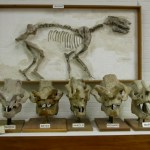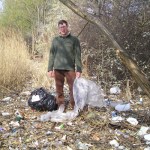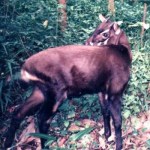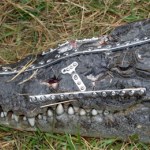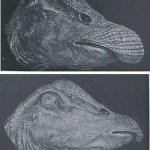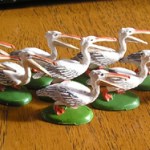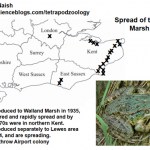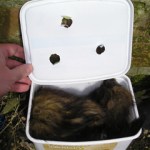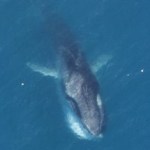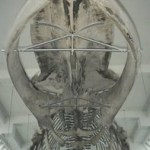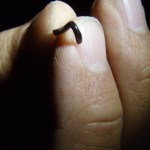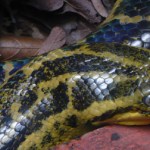
Here's a photo Matt Wedel took in the Raymond Alf Museum in Claremont, California. The lined-up skulls belong (I think) to Megacerops, the large to very large Late Eocene brontothere previously known as Brontotherium. Like most other brontotheriine brontotheres it has reduced, globular upper incisors and is very wide at the back of the skull. The upper incisors were in fact so small that they might have been virtually useless, and these animals probably relied on a prehensile lip to gather food. Must stop there - want to start talking about horns and evidence for intraspecific combat, but…
Last weekend I did the beach clean-up thing again, and again I went along with my son, my mum (Sandra), and about 40 other people. There's always something new to say about the problem of litter and plastic pollution: once again, I thought I'd pen some random musings on the experience, and on the problem of litter and pollution in general.
There's every reason to be depressed about the fact that, thanks to our species, many environments and ecosystems are royally screwed, but there's hope in the fact that more and more people are at least aware of the situation, and more and more are acting…
By complete coincidence - honestly! - we looked yesterday at discovery rates among terrestrial mammals. All indications are that many species remain to be discovered. It should also be well known, and I hope it is, that the same is true for large marine vertebrates: recent discoveries, and extrapolations based on discovery rates, indicate that there are still new, large marine animals to find. Today sees the publication of a new paper by myself and two colleagues, Michael Woodley and Hugh Shanahan, in which we attempt to estimate the number of pinnipeds that might remain undiscovered (…
Hopefully it is well known that we still have a lot to learn about the planet's extant macrofauna. And, by 'macrofauna', I'm not talking about nematodes, molluscs or insects but, yes, about such things as mammals. In fact, on mammals specifically, discovery rates indicate that we really should expect the discovery of new species for a long while yet. In a new article in Proceedings of the National Academy of Sciences, Ceballos & Ehrlich (2009) bring attention to the fact that 408 new mammal species (representing about 10% of the total mammal species inventory and belonging to 18…
Tales of animals that have undergone reconstructive surgery, or end up with prosthetic attachments, always make the news: wheels in place of tortoise legs [example] and that sort of thing. As reported in the Mail online (and other sources) a few days ago, during December 2008 an unfortunate 3-m long, wild American crocodile Crocodylus acutus was run over by a car, in Florida. The animal sustained substantial head injuries: apparently its snout was 'hanging limp' and it was unable to feed. It was captured and taken to the Miami MetroZoo [images below © Barcroft Media].
Here, plans were made…
Before I start: TIANYULONG TIANYULONG TIANYULONG TIANYULONG TIANYULONG.
Ok, moving on...
It is the contention of some that the field of Mesozoic reptile research is plagued with bizarre, nonsensical hypotheses. You may or may not agree with me that skim-feeding giant pterosaurs, wind-surfing sail-crested pterosaurs, dedicated-to-scavenging Tyrannosaurus, and crampon-using dromaeosaurs are all, shall we say, unlikely. In some cases the science has been done to smack these ideas down, in other cases it has not. In my opinion, one of the most illogical hypotheses entertained within recent…
Firstly, happy Tianyulong day! How incredibly cool. Secondly, this is an annoying teaser - full post to appear soon. Sorry, but c'est la vie.
Ok, here we are: welcome to the fifth and final part of that 'month in dinosaurs (and pterosaurs)' series (for previous parts: part I, part II, part III, part IV). This time, more pterosaurs...
In the previous article we looked at the new tiny pterosaur Ningchengopterus (a juvenile Eosipterus?), and at new ideas on nyctosaur crest function. However, another very interesting pterosaur paper appeared in January 2009: Dyke et al.'s (2009) look at morphological disparity in pterosaurs across time. For the record, 'disparity' refers to the degree of morphological variation seen within a clade. It…
Already the article you're reading is several weeks late, and I had to make a real effort to finish it before those weeks became months. Anyway, I present here the penultimate in the 'month in dinosaurs (and pterosaurs)' series (for the previous articles please see part I, part II, and part III). The whole point of this little series was to discuss what happened during January 2009 in dinosaur and pterosaur research. So, we've done the dinosaurs (or, at least, the theropods and ornithischians). This time: pterosaurs. Before launching into the new stuff, I must note that a single, exceptional…
No time. Too busy. Toy pelicans from Marwell Zoo. Accompanying thoughts from Dave Hone here; involves azhdarchids. Bye now, sorry for lack of substantive content.
Yeah, like it says in the title.. what is wrong wih this hippo? (photographed at Plymouth Museum and Art Gallery). Or, 'was' wrong.. given that it's now dead. I really should say more about hippos at some stage. So far there's only this, and that's just not good enough.
What fun we've all had, discussing corpses and decomposition. Thanks to all who participated. I'm going away for a couple of days. For no good reason other than that it looks good, find here a slide from a talk I do called 'Britain's changing herpetofauna'. I think it's pretty self-explanatory! The pic of the Marsh frog Pelophylax ridibundus is by Neil Phillips - thanks Neil :)
Like some most virtually all hopefully all people interested in animals, I have a dark, guilty secret: I covet and collect dead bodies. In fact I'm of the opinion that if you're interested in animals and are not interested in dead bodies, there's something wrong with you. How can you not be interested in - nay, fascinated by - anatomy, variation and functional morphology, and how are you going to learn about this if not by looking at, and manipulating, dead bodies and their constituent parts? Few of us have ready access to museum collections, and building up a collection of specimens…
Like many 'generalised' carnivores, the Common or Harbour seal Phoca vitulina is a surprisingly adaptable predator, even if it is rather conservative in diet and choice of foraging habitat (e.g., Tollit et al. 1998). This photo, taken by Philip Kirkham, is part of a sequence in which a seal stalks, catches, and then dismembers and eats a duck (the duck is a Common eider Somateria mollissima). We all know that such pinnipeds as Leopard seals Hydrurga leptonyx and various sea lions and fur seals routinely catch and eat birds (Todd 1988), but it's a bit surprising to see the small, normally…
Not only am I now unable to edit my blogroll (a very minor thing, but one that bugs me nonetheless), I am also incapable of understanding how ResearchBlogging is supposed to work. I registered, but cannot get my posts to appear there, so am going to give up. Oh well, it's not like it matters I suppose (hmm, or does it?). Am currently busy with the books, and am also (with co-authors) putting the finishing touches to some very neat papers... on which all will be revealed in due time. Anyway, to business, and to the last of those rorqual articles. Please see part I and part II first. The…
More on those rorquals: part I is required reading. To those who have seen this stuff before: sorry, am going through a busy phase and no time for new material (blame dinosaurs and azhdarchoid pterosaurs... and baby girls). Oh, incidentally, I recently registered Tet Zoo with ResearchBlogging: I haven't done this before because 'blogging on peer-reviewed research' is the norm at Tet Zoo, not the exception. It seems to take ages for posts to be uploaded to ResearchBlogging - like, hours. Is this normal? Anyway...
This time we look at the basics of rorqual morphology and at their feeding…
Sorry, nothing new: time again for something from Tet Zoo ver 1...
Late in the 1920s, plans to replace the old whale hall of the British Museum (Natural History) were fulfilled. Thanks to the new, steel-girdled hall, the Blue whale skeleton - by now kept in storage for 42 years due to lack of space - could finally be put on display [adjacent image, © NHM]. This skeleton belonged to a 25 m animal that had stranded at Wexford Bay, SE Ireland, in 1891. It - as in, the skeleton alone - weighs over 10 tons. But some people at the museum wanted more, and in 1937 taxidermist Percy Stammwitz (1881-…
Dave Hone - who's had more than his fair share of mentions here at Tet Zoo over the past several days - accompanied me on a visit to Marwell Zoo yesterday. We had a great time, but unfortunately got all too little paper-writing done :) (after all, this is what scientists normally do when they meet up). There's always something new to see, or experience, at the zoo. The Frill-necked lizards Chlamydosaurus kingii were brand-new, for example: it was in fact only their second day on exhibit. And I've never heard a Snow leopard Panthera uncia roar before. It didn't sound like any other big cat…
More snakes, because - thanks to Dave Hone - I have some more pictures to use (and, I'll be honest, at least some of my posts are 'picture-driven'). We've looked previously at the unusual, mostly small, worm-like, burrowing snakes grouped together as the scolecophidians here. In that article, however, I didn't really emphasise the small size of some scolecophidian species. This photo - taken by Dave in Mexico (is that Dino Frey holding the animal?) - makes the point well.
The smallest scolecophidians are Caribbean leptotyphlopids (aka threadsnakes, wormsnakes or slender blindsnakes)…
Anyone who's anyone has heard of the Anaconda. But in fact 'the' Anaconda is the Green anaconda Eunectes murinus. Most zoologically-informed people know that there's a lesser-known, smaller relative of this large species, namely the Yellow or Paraguayan anaconda E. notaeus. Usually only reaching 3-4 m in length (as opposed to 5-9 m for the Green anaconda), the Yellow anaconda [photo here by Dave Hone] typically has a yellowish ground colour, and black spots, patches and streaks decorate its length.
Far less well known is that there are actually a few other anacondas as well. The Dark-…
